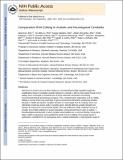Comparative RNA editing in autistic and neurotypical cerebella
Author(s)
Eran, A.; Li, J. B.; Vatalaro, K.; McCarthy, J.; Rahimov, F.; Collins, C.; Markianos, K.; Margulies, David M.; Calvo, Sarah E.; Kohane, Isaac; Kunkel, Louis M.; Brown, Emery N.; ... Show more Show less
DownloadBrown_Comparative RNA.pdf (2.247Mb)
OPEN_ACCESS_POLICY
Open Access Policy
Creative Commons Attribution-Noncommercial-Share Alike
Terms of use
Metadata
Show full item recordAbstract
Adenosine-to-inosine (A-to-I) RNA editing is a neurodevelopmentally regulated epigenetic modification shown to modulate complex behavior in animals. Little is known about human A-to-I editing, but it is thought to constitute one of many molecular mechanisms connecting environmental stimuli and behavioral outputs. Thus, comprehensive exploration of A-to-I RNA editing in human brains may shed light on gene–environment interactions underlying complex behavior in health and disease. Synaptic function is a main target of A-to-I editing, which can selectively recode key amino acids in synaptic genes, directly altering synaptic strength and duration in response to environmental signals. Here, we performed a high-resolution survey of synaptic A-to-I RNA editing in a human population, and examined how it varies in autism, a neurodevelopmental disorder in which synaptic abnormalities are a common finding. Using ultra-deep (>1000 × ) sequencing, we quantified the levels of A-to-I editing of 10 synaptic genes in postmortem cerebella from 14 neurotypical and 11 autistic individuals. A high dynamic range of editing levels was detected across individuals and editing sites, from 99.6% to below detection limits. In most sites, the extreme ends of the population editing distributions were individuals with autism. Editing was correlated with isoform usage, clusters of correlated sites were identified, and differential editing patterns examined. Finally, a dysfunctional form of the editing enzyme adenosine deaminase acting on RNA B1 was found more commonly in postmortem cerebella from individuals with autism. These results provide a population-level, high-resolution view of A-to-I RNA editing in human cerebella and suggest that A-to-I editing of synaptic genes may be informative for assessing the epigenetic risk for autism.
Date issued
2012-08Department
Harvard University--MIT Division of Health Sciences and Technology; Massachusetts Institute of Technology. Department of Brain and Cognitive SciencesJournal
Molecular Psychiatry
Publisher
Nature Publishing Group
Citation
Eran, A, J B Li, K Vatalaro, J McCarthy, F Rahimov, C Collins, K Markianos, et al. “Comparative RNA Editing in Autistic and Neurotypical Cerebella.” Mol Psychiatry 18, no. 9 (September 2013): 1041–1048.
Version: Author's final manuscript
ISSN
1359-4184
1476-5578